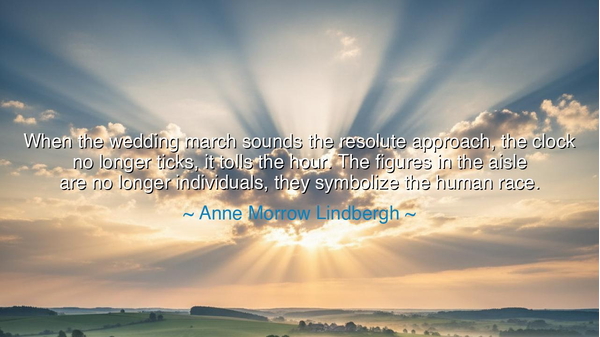
When the wedding march sounds the resolute approach, the clock
When the wedding march sounds the resolute approach, the clock no longer ticks, it tolls the hour. The figures in the aisle are no longer individuals, they symbolize the human race.






The words of Anne Morrow Lindbergh shine with reverence and awe: “When the wedding march sounds the resolute approach, the clock no longer ticks, it tolls the hour. The figures in the aisle are no longer individuals, they symbolize the human race.” In this vision, a wedding is lifted beyond the realm of private joy and placed upon the stage of eternity, where two lives become the emblem of all love, all longing, all union since the dawn of humankind.
The wedding march, so familiar to the ear, becomes here more than music. It is a summons, like the trumpet of the ancients, calling not only bride and groom but all who witness into the sacred rhythm of life. When its notes rise, time itself seems to shift. The ordinary ticking of the clock gives way to destiny’s toll, for what unfolds is not merely an event of the day, but an hour written into the fabric of humanity’s story.
History and myth alike reveal this truth. In every culture, from the joining of tribes by marriage in ancient times to the royal weddings of Europe that sealed peace between warring nations, the figures in the aisle have represented more than themselves. They have stood as symbols of hope, reconciliation, continuity, and the eternal union of man and woman. Their steps forward carry the weight not only of personal vows, but of the endless procession of lovers who came before and those who will follow.
Lindbergh’s words also capture the paradox of a wedding: that in this most personal of moments, the individual fades into the universal. The bride and groom are still themselves, yet in their union they become archetypes—the eternal bride and groom, enacting before witnesses the drama that keeps the human race alive and renewed. They no longer speak only for themselves, but for the mystery of love itself, which binds not just two, but all.
Therefore, let this wisdom be preserved: every wedding is both intimate and cosmic, both tender and heroic. It is the binding of two souls and the echo of humanity’s eternal longing for wholeness. When the music sounds and the aisle is walked, we behold not only a marriage, but the triumph of love as the force that sustains the race of man. And in that hour, time itself pauses, honoring the sacred union that is at once private joy and universal truth.






ATNong Thi Anh Thu
Reading this, I feel both awe and melancholy. The language evokes how monumental a wedding can feel, as if time itself stands still. Yet there’s also a reminder of how fleeting our individuality is in the face of universal human experiences. Maybe Lindbergh is reminding us that love, in its truest form, is both deeply personal and profoundly collective—a bridge between two hearts and all of humanity.
HCNguyen Ha Chau
What strikes me is the blending of romance and existential reflection. Lindbergh elevates the wedding beyond sentiment—it becomes a metaphor for human continuity. The couple in the aisle are no longer just lovers; they’re archetypes of all who have loved and committed before them. But I wonder—does seeing marriage this way make it more meaningful, or does it strip away the personal, intimate side of love?
TVMai Thao Vu
There’s something almost spiritual in this imagery. The idea that time pauses and individuals become symbols reminds me of how ceremonies connect us to humanity’s deeper rhythms. Yet, I also sense a somber undertone—the ‘tolling’ feels like both celebration and mortality. Is Lindbergh suggesting that every union carries within it both love and loss, like two sides of the same timeless coin?
DQKhanh Dinh Quoc
This statement makes me reflect on the idea that certain life events—like marriage—transcend personal emotion and enter a kind of collective meaning. It’s fascinating how Lindbergh captures that shift from private to universal. But is that symbolism still relevant today, when marriage is becoming more individualized and diverse? Maybe we’ve lost touch with that sense of shared ritual and reverence.
CFChuan FiFa
I find this line hauntingly beautiful. The imagery of the clock tolling instead of ticking gives such a sense of finality and transformation. It’s as if the moment of marriage marks a crossing into something eternal. But I can’t help but question—does this idealization place too much pressure on the couple? How can two individuals bear the weight of symbolizing the entire human race?